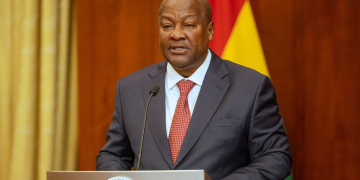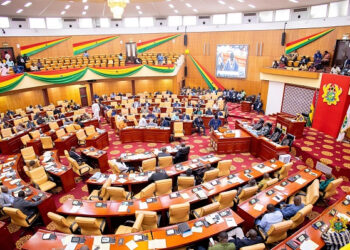President Nana Addo Dankwa Akufo-Addo directed the Engineering Council of the Ministry of Works and Housing on Thursday to perform a thorough integrity audit of all public buildings in order for the government to prepare efficiently for earthquakes and other natural disasters.
He has also advised the Ghana Geological Survey Authority to advise the government on the logistical requirements and facilities necessary to conduct round-the-clock monitoring of seismic activity in order to take appropriate action.
The President made the call on Thursday in Accra, while addressing a stakeholder conference on Ghana’s earthquake preparedness and reaction.
The Ministry of the Interior organized the conference, which was titled “Building Resilience to Earthquakes – A National Priority.”
It would consider the report of a ten-member Committee convened by the Interior Ministry in 2019 to develop a mechanism for refocusing the country’s earthquake preparedness and response.
President Akufo-Addo said that given Ghana’s history of seismic activity dating all the way back to 1636, including a catastrophic one that struck Accra in 1939, as well as recent tremors in the region, there was a need to ensure that casualties were minimized in the event of a large earthquake.
“It is important to understand what to do in the case of an earthquake. It is important that all Ghanaians understand how to stay healthy and alive in the event that such an unfortunate event occurs in the future,” he added.
“We must ensure that structures, such as houses, dams, and bridges, are structurally sound and robust to earthquakes of greater magnitude.”
“It cannot be undermined that well-engineered infrastructure, such as dams and bridges, and critical public lifeline facilities, such as clinics, colleges, churches, and mosques, are constructed and retrofitted.”
The President reaffirmed the government’s responsibility to protecting the entire citizenry from the impact of earthquakes and other natural hazards.
“The government has adequately demonstrated its commitment to preparing the country to withstand the impact of disasters, and we will continue to prepare NADMO (National Disaster Management Organization) and, indeed, all response agencies to improve their organizational effectiveness,” he added.
President Akufo-Addo urged the NADMO to launch a continuous national education programme on the country’s earthquake preparedness and response plans, and requested reports on results.
He urged the ministers of Works and Housing, as well as local government, decentralization, and rural development, to cooperate with the Ghana Institution of Engineers to create a scheme requiring homeowners to retrofit their homes to make them earthquake-resistant.
Additionally, the arrangement will obligate prospective home owners to construct in compliance with defined requirements.
The President reaffirmed his order to the leadership of NADMO to collaborate with the Ghana Education Service to integrate learning themes on disaster preparedness into pre-tertiary education curricula.
The ten-member Committee’s report recommends interventions to help Ghana improve the capacity to deal with and rebound from the effects of a major earthquake, while avoiding measures that jeopardize the country’s ability to develop and impose unnecessary financial burdens on individuals and the state.
It defines and summarizes the critical steps that must be taken by appropriate authorities to brace communities for seismic risk and assesses the capacity of relevant entities charged with national response in order to identify resource gaps.
Additionally, the study recommends retrofitting current buildings exposed to natural hazards to prevent further disruption and requests that the Ghana Building Code be updated to provide specifications for retrofitting infrastructure.
It requires owners of public buildings and buildings with a high density of inhabitants, as well as operators of critical infrastructure such as electricity, water, ports, bridges/interchanges, and telecommunications infrastructure, to conduct a thorough review of their facilities and retrofit them to meet appropriate requirements within a defined time frame.
Read Also: Cape Coast Teaching Hospital receives a donation from a family
Cities such as Accra, Tema, Ho, Cape Coast, and Takoradi, as well as critical infrastructure in the south of Ghana such as those for connectivity, power, oil and gas, and energy, as well as some iconic national infrastructure, all lie inside earthquake-prone zones.
Ghana’s earthquake risks are usually measured by three major sources: the coastal border fault, which runs parallel to the country’s shore, the Akuapim fault region, which is comprised of a chain of faults running across the Akuapim Mountain range, and the Ivory Coast fault, which runs through the country’s south-western corner.
Past earthquakes in Ghana and an analysis of current conditions by the Ghana Geological Survey Authority (GGSA) have shown that a wide variety of secondary effects such as explosions, floods from burst pipelines and dams, tsunamis, landslides/rock falls, and liquefaction are all likely in the country as a result of heavy ground shaking.
The NADMO, National Security, the GGSA, the Land Use and Spatial Planning Authority, the Ghana Health, Ambulance, National Fire and Police services, and the Ghana Armed Forces are all represented at the meeting.
SOURCE: ATLFMONLINE


























